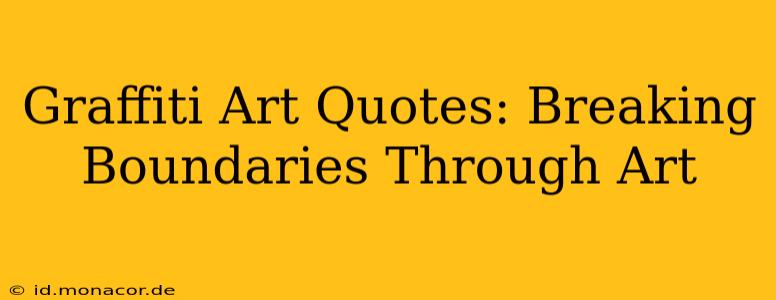Graffiti art, a vibrant and often controversial form of expression, has captivated audiences for decades. More than just vandalism, it's a powerful medium for social commentary, self-expression, and artistic innovation. This exploration delves into the world of graffiti art quotes, examining their significance, impact, and the artists who wield them as tools for change. We'll also explore some of the most thought-provoking questions surrounding this unique art form.
What are some famous graffiti art quotes?
Pinpointing specific "famous" quotes directly attributed to graffiti artists is tricky. Much of graffiti art's power lies in its visual impact and the unspoken narratives within the artwork itself. However, the essence of many pieces can be encapsulated in phrases that reflect the spirit of the movement. Think of statements like "Art is rebellion," "The streets are our canvas," or "Silence is consent." These aren't direct quotes from specific artists but rather encapsulate the ethos of the graffiti art movement, reflecting the artists' desire to challenge norms and express themselves in unconventional ways. The power often lies not in the words themselves but in the placement, style, and overall message conveyed through the artwork.
What is the impact of graffiti art quotes?
Graffiti art quotes, whether explicitly stated or implied through imagery, create a powerful dialogue with the viewer. These messages can range from political statements and social critiques to personal reflections and artistic manifestos. Their impact is multifaceted:
-
Social Commentary: Many graffiti artists use their work to address social injustices, political corruption, or environmental concerns. The quotes, either written directly or implied through imagery, amplify these messages, making them instantly accessible to a broad audience.
-
Self-Expression: For many artists, graffiti is a potent tool for self-expression, a way to communicate personal struggles, triumphs, and identities in a public space. The quotes embedded within the artwork serve as personal manifestos or emotional outlets.
-
Aesthetic Impact: The style and presentation of graffiti art quotes are as significant as the message itself. The bold lettering, vibrant colors, and innovative techniques used in creating the artwork contribute to its overall impact and aesthetics.
How does graffiti art challenge traditional art forms?
Graffiti art fundamentally challenges the traditional art world's norms by circumventing established galleries and institutions. It’s a direct form of communication, bypassing intermediaries and engaging directly with the public in unconventional spaces. This challenges the idea of what constitutes "art" and where it can be displayed. The ephemeral nature of some graffiti, its vulnerability to removal, and its often illegal status further differentiate it from traditional art forms.
Is graffiti art vandalism or art?
The age-old question remains: is graffiti art vandalism or a legitimate art form? The answer is nuanced and depends largely on context, intent, and legality. Many pieces are created illegally, on private property without permission, which constitutes vandalism. However, much commissioned graffiti art graces public and private spaces with permission, transforming the aesthetic of urban environments. The line between vandalism and art is often blurry, and each piece must be viewed individually, considering its location, intent, and the laws governing it.
What legal and ethical considerations surround graffiti art?
Graffiti art’s existence within a legal gray area raises several legal and ethical considerations:
-
Property Damage: Unauthorized graffiti on private property constitutes vandalism and can lead to legal repercussions for the artist.
-
Consent and Permission: Obtaining permission to create graffiti art is crucial to avoiding legal issues and ensuring ethical practice.
-
Public vs. Private Space: The debate over the use of public spaces for artistic expression versus the need to protect public property remains a central tension.
-
Copyright and Intellectual Property: Protecting the copyright of graffiti art can be challenging given the public nature of the works.
Conclusion:
Graffiti art, with its powerful imagery and impactful statements, continues to redefine the boundaries of art. While the legal and ethical aspects remain a complex topic of discussion, its enduring influence on urban aesthetics and social commentary is undeniable. The quotes, whether explicit or implicit, represent a powerful voice, often ignored but undeniably present. The discussion continues, and with every new piece, the conversation evolves.

